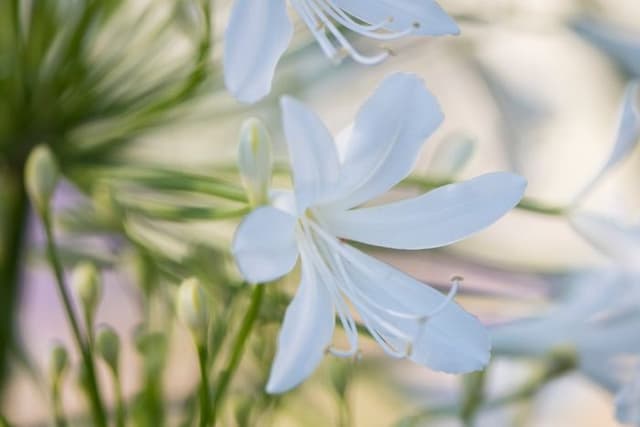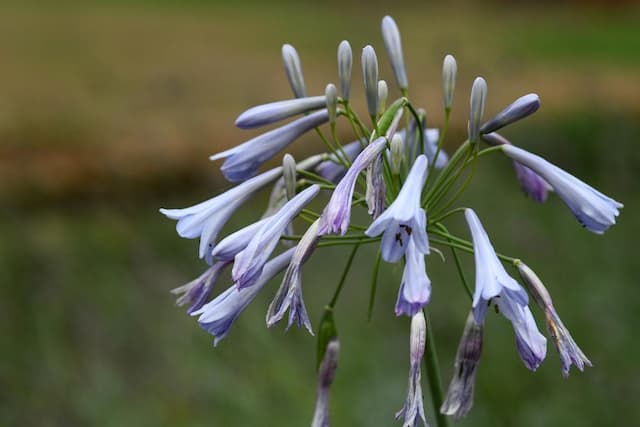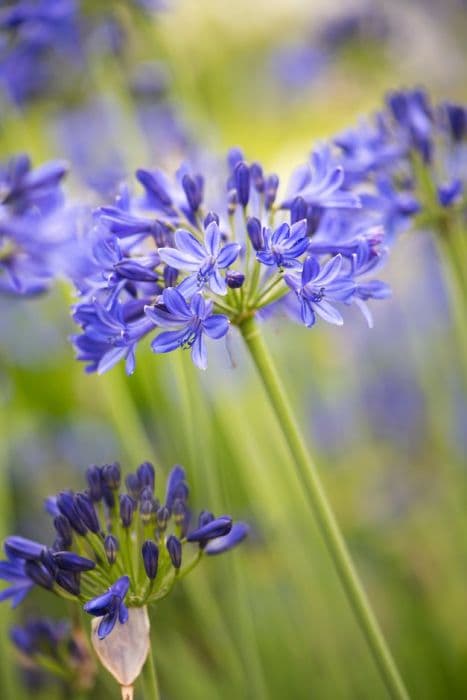African Lily Agapanthus Queen Mum = 'Pmn06' (PBR)
![African lily [Queen Mum]](/_next/image?url=https%3A%2F%2Fplants-admin.emdemapps.com%2Fimages%2Fplants%2F%2Fimages%2F604b63b87c8aa.png&w=3840&q=75)
ABOUT
Agapanthus Queen Mum is popularly known for its striking bloom display featuring large, spherical flower clusters that sit atop sturdy, upright stems. The individual blossoms within each cluster exhibit a charming bicolored pattern, typically showcasing a blend of pristine white petals that transition to a rich, vivid blue at their base. The shape of the flowers is trumpet-like, contributing to an elegant and ornamental feel. The foliage forms a lush, strap-shaped base with green leaves that gracefully arch outward, creating a dense and attractive cover. This plant's overall visual impact is sculptural and eye-catching, making it a favorite amongst garden enthusiasts for its dramatic and colorful floral presentation.
About this plant
 Names
NamesFamily
Amaryllidaceae
Synonyms
Queen Mum Agapanthus, African Lily, Lily of the Nile
Common names
Agapanthus Queen Mum = 'Pmn06' (PBR)
 Toxicity
ToxicityTo humans
The Agapanthus, commonly known as Lily of the Nile or African Lily, has varying levels of toxicity among different species and cultivars. While Agapanthus Queen Mum specifically might not have widely documented cases of toxicity, Agapanthus plants in general can cause mild toxicity if ingested by humans. The symptoms of Agapanthus poisoning can include gastrointestinal upset, such as nausea, vomiting, and diarrhea. In some cases, particularly if large quantities are consumed, more severe symptoms could emerge. It is advised to avoid ingesting any parts of the plant, and if ingestion occurs, to seek medical attention.
To pets
The Agapanthus, commonly referred to as Lily of the Nile or African Lily, is known to be toxic to pets, including dogs and cats. If a pet ingests any part of the Agapanthus plant, they may exhibit symptoms such as vomiting, diarrhea, and drooling. In more severe cases, ingestion can lead to lethargy, abdominal pain, and anorexia. The toxins present in Agapanthus can affect the gastrointestinal system and can be harmful to pets. It's important to keep this plant out of pets' reach and to seek veterinary care immediately if you suspect your pet has ingested any part of an Agapanthus plant.
 Characteristics
CharacteristicsLife cycle
Perennials
Foliage type
Evergreen
Color of leaves
Green
Flower color
Mixed
Height
4 feet (1.22 meters)
Spread
2 feet (0.61 meters)
Plant type
Bulb
Hardiness zones
8
Native area
South Africa
Benefits
 General Benefits
General Benefits- Attractive Blooms: The Agapanthus Queen Mum boasts large, striking blue and white flowers that can add visual interest to any garden setting.
- Drought Tolerance: Once established, it has a degree of drought tolerance, making it suitable for gardens in regions with water scarcity.
- Low Maintenance: It requires minimal care apart from occasional watering and feeding, making it ideal for busy gardeners.
- Long Flowering Period: The plant has a lengthy blooming season which ensures colorful displays for extended periods, usually from early summer to early fall.
- Landscape Versatility: Its elegant appearance fits well in various garden styles such as borders, containers, and as a focal point in garden beds.
- Attracts Pollinators: The trumpet-shaped flowers are known to attract bees and butterflies, supporting local ecosystems.
- Deer Resistance: Agapanthus plants are generally not preferred by deer, reducing the likelihood of damage in areas with deer populations.
- Coastal Suitability: It is tolerant of coastal conditions, such as salty air and winds, making it ideal for seaside gardens.
 Medical Properties
Medical PropertiesThis plant is not used for medical purposes.
 Air-purifying Qualities
Air-purifying QualitiesThis plant is not specifically known for air purifying qualities.
 Other Uses
Other Uses- The tall flower stalks of the Agapanthus can be used in large, dramatic flower arrangements or as a centerpiece in floral design.
- Dried seed heads of the Agapanthus can be used in creating rustic and natural decorative wreaths or as part of dried flower arrangements.
- The sap of Agapanthus, which is sticky, has been used in traditional crafts for its adhesive properties.
- Agapanthus leaves can be woven into baskets or mats in some cultures, utilizing their length and fibrous nature.
- The flowers can be used as a natural dye, providing a soft blue hue to textiles or artisanal crafts.
- The sturdy leaves of Agapanthus can serve as natural wraps for small packages or as biodegradable "ribbons" in eco-friendly gift wrapping.
- In artistic photography, the striking blooms can provide a vivid subject matter or a backdrop for nature-inspired portraits.
- The contrast between the Agapanthus' blue flowers and green foliage can be used to create visually appealing patterns in landscape mosaics or garden design.
- Due to their height and shape, Agapanthus plants can be strategically placed in gardens to provide subtle privacy screens in outdoor seating areas.
- The use of Agapanthus plants in stormwater management gardens helps in soil erosion control due to their extensive root system.
Interesting Facts
 Feng Shui
Feng ShuiThe Agapanthus, commonly known as Lily of the Nile, is not traditionally used in Feng Shui practice.
 Zodiac Sign Compitability
Zodiac Sign CompitabilityThe Lily of the Nile is not used in astrology practice.
 Plant Symbolism
Plant Symbolism- Love of Nature: Agapanthus, commonly known as Lily of the Nile or African Lily, often symbolizes a deep appreciation for nature and wild beauty, as it is a plant that thrives both in cultivated gardens and in untamed landscapes.
- Enduring Love: The name "Agapanthus" comes from the Greek words "agape" (love) and "anthos" (flower), suggesting the flower is a symbol of an enduring and steadfast love.
- Fertility and Pregnancy: In some cultures, the lush, full blooms of the Lily of the Nile are associated with fertility and motherhood, making the plant a common gift for expecting mothers or as a symbol of good luck for families hoping to conceive.
- Beauty: With its striking blue and white flowers, the Agapanthus Queen Mum is often associated with beauty, elegance, and a majestic presence in the garden, standing out amongst other plants.
- Protection: In South African tradition, Agapanthus is believed to have protective qualities and is often planted around homes to ward off lightning and evil spirits.
- Freedom: The Agapanthus can also represent freedom due to its growth pattern; it blossoms freely in the summer and its seeds spread with ease, symbolizing an unbound and independent spirit.
 Water
WaterLily of the Nile should be watered deeply to encourage root development, approximately once a week during the active growing season. During the hot summer months, you might need to water twice a week if the soil dries out quickly. Ensure that the plant receives about 1 gallon of water per watering session. In the winter, reduce watering to every two to three weeks, or just enough to prevent the soil from completely drying out. Adjust the frequency based on rainfall and check the soil moisture regularly to avoid overwatering.
 Light
LightLily of the Nile thrives in full sun conditions where it can receive at least 6 hours of direct sunlight daily. It can tolerate some partial shade, especially in the hottest parts of the day, but flowering may be reduced. The best spot for this plant is in an area with bright, unfiltered sunlight to promote abundant blooms.
 Temperature
TemperatureLily of the Nile prefers moderate temperatures and does best in a range between 50°F and 80°F. It can survive minimum temperatures down to about 20°F, but frost can damage the foliage. The ideal conditions are temperate, avoiding extremes of cold and heat to ensure healthy growth and flowering.
 Pruning
PruningPrune Lily of the Nile after flowering to remove spent flower stalks and encourage a tidy growth habit. Additionally, cut back any damaged or brown foliage in the spring. Pruning is typically done annually, and the best time for this is late winter or early spring before new growth begins.
 Cleaning
CleaningAs needed
 Soil
SoilThe Lily of the Nile (Agapanthus 'Queen Mum') thrives in a well-draining soil mix consisting of loam, sand, and compost, with a pH range of 6.0 to 8.0. Rich organic matter will promote healthy growth and blooming.
 Repotting
RepottingLily of the Nile should be repotted every 2 to 3 years or when it becomes root-bound. Use a larger pot to give the roots room to expand.
 Humidity & Misting
Humidity & MistingLily of the Nile prefers moderate humidity levels but is quite adaptable and can tolerate the typical humidity found in most outdoor environments.
 Suitable locations
Suitable locationsIndoor
Place in bright light, ensuring ample space for growth.
Outdoor
Plant in full sun, protect from harsh frosts.
Hardiness zone
8-11 USDA
 Life cycle
Life cycleAgapanthus Queen Mum, commonly known as the Lily of the Nile, starts its life cycle as a seed which, when sown, germinates to produce a small seedling. The seedling grows into a vegetative plant with strap-like leaves and a robust root system. Over time, the plant reaches maturity and develops tall, sturdy stalks that bear clusters of white and blue bicolored flowers during the summer months. After the flowering period, seed pods may form, containing seeds that can be dispersed to produce new plants. Throughout its life, Agapanthus Queen Mum undergoes periods of active growth and dormancy, aligning with seasonal changes; the plant typically enters a dormant phase during colder months. With appropriate care, including division every few years to prevent overcrowding, the Lily of the Nile can live for many years, continuing its life cycle through vegetative propagation or seed production.
 Propogation
PropogationPropogation time
Spring-Early Summer
The most common method for propagating the Agapanthus 'Queen Mum' is by division. This involves separating the plant's clumps into smaller sections with a sharp knife or spade, ensuring that each section has at least one or two growing points or shoots. The best time to carry out this process is in early spring or after the plant has finished flowering. Once divided, replant the sections immediately into well-draining soil, spacing them about 12 to 18 inches (approximately 30 to 45 centimeters) apart to allow for adequate growth and airflow. Water the newly planted sections well to help establish their root systems. This method of division helps to rejuvenate older plants while also allowing gardeners to multiply their stock of these beautiful flowering plants efficiently.







![African lily [Brilliant Blue]](/_next/image?url=https%3A%2F%2Fplants-admin.emdemapps.com%2Fimages%2Fplants%2F%2Fimages%2F604b5e3c28e2b.png&w=640&q=75)

